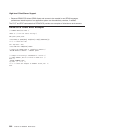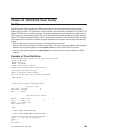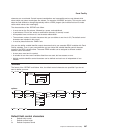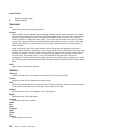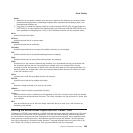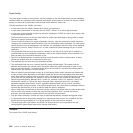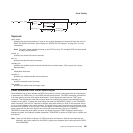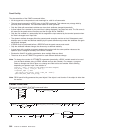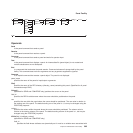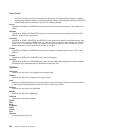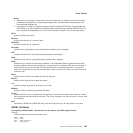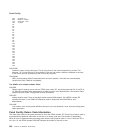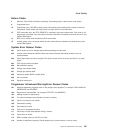
The panel layout is close to what you see, with the exception of the control characters and the imbedded
variables which are not shown when the panel is displayed. A field typed on the third line after the .PANEL
starting at column ten is positioned on the terminal screen third line, column ten.
The characteristics of the .PANEL verb follow.
v It must start in the first column, followed by a space, and capitalized.
v It must have a panel name on the same line as .PANEL, unless it is an end of panel indicator.
v It must have at least one field and the first character following the .PANEL line has to be a protect, skip,
or unprotect control character.
v The field ends at the start of the next field unless an explicit input field length is being used. An empty
field can be used to terminate a field.
v To use a control character as a regular displayable character, type two consecutive control characters.
To display two consecutive control characters, type four consecutive control characters. For each pair of
control characters that get displayed as one character, the subsequent text in the field will be displayed
one position to the left, except if there are 7 or more consecutive spaces following the pair of control
characters.
v The protect/skip field can have any number of variables or text that will fit in that field. A variable in a
protected field has area available for substitution, starts at the variable identifier control character, and
ends just before the next control character or text.
v Space is not allowed between a variable identifier control character and the variable name. A space
causes the variable name to be interpreted as plain text.
v The unprotect field can have only one associated variable.
v The unprotected field can have a number explicitly stating the field length. The number must be
between the unprotect and variable control characters. When the explicit field length is used, a field
does not need termination. If an explicit length field is the last field of a line then a terminating field is
created with a skip attribute to force a field end.
v When an explicit input field length is used, all of the following field's column positions are adjusted left
or right to force proper alignment, so the explicit length field and the field immediately after abut each
other. Other fields on that line keep its spacing intact. This alignment only affects that one line, the fields
on the next line are unaffected. For example, a line has 5 fields with the 1st and 4th fields having
explicit length and spacing. Between fields 1 and 2 is 4, between 2 and 3 is 5, between 3 and 4 is 6,
and between 4 and 5 is 7. When this line is displayed, field 2 starts right after field 1 (no space),
separation between fields 2 and 3 is still 5, separation between fields 3 and 4 is still 6, and field 5
follows right after field 4 (no space). If the explicit length causes the current field or subsequent fields to
overflow into the next field, an error is returned when the panel is displayed.
v When a field does not terminate on the same line (for example, field spans lines), the field length varies
with the width of the screen on which the panel is being displayed. Also, if the last field has no
terminator, that field wraps the screen until the first field start is encountered.
v Only the fields containing a variable can have its attributes dynamically changed during panel output.
v If a protect/skip field is dynamically changed to an unprotected field, only the first variable in the field
has the operator input assigned to it. All of the contents of the input field are assigned.
v The panel source file must reside in the REXX File System before it can be processed into the
intermediate file (panel object) used by the runtime panel facility.
.PANEL
The format of the .PANEL verb follows.
Panel Facility
300
CICS TS for VSE/ESA: REXX Guide



